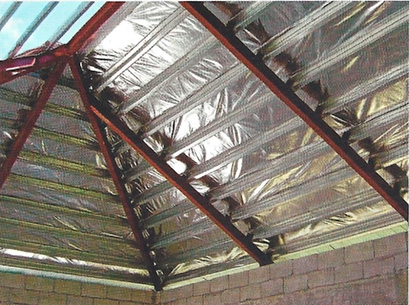
Insulation might be cheaper to install, but radiant barriers could save more energy in the long run. People living in colder climates won’t get nearly as much benefit from a radiant barrier as someone living around The Greater Bay Area.īudget matters. For homeowners in hot areas, radiant barriers are a great option. If you’re shivering inside in winter, insulation could be your most sensible option. If your attic feels like an oven in summer, a radiant barrier might be the ticket. Now that you understand the differences between radiant barriers and insulation, how do you choose what’s best for you? Here are some things to think about:įirst, understand your home’s needs. Making the Right Choice: Factors to Consider

You’ll still be saving your air conditioners and furnaces from doing a lot of extra work. The radiant barrier will still reflect radiant energy, but the effect on your home’s temperature will be minimal. In cooler climates, insulation can keep your home toasty. In hot climates, a radiant barrier can reflect the sun’s heat away, and insulation can slow down any heat that gets through. Why choose just one insulation method when you can have both? Yes, radiant barriers and insulation can team up to make your home even more energy efficient against heat and cold. Combining Radiant Barriers and Insulation Climate-wise, insulation works well in all climates, while a radiant barrier does its best work in warm climates.
#ATTIC RADIANT BARRIER INSULATION PROFESSIONAL#
Installation-wise, insulation is generally easier to install, but a radiant barrier might need a professional touch. Longevity-wise, a radiant barrier can last longer than some types of insulation, like fiberglass, which can degrade over time. Insulation slows down all types of heat transfer, while radiant barrier reduces the amount of radiant heat by reflecting it back outside.Ĭost-wise, insulation is usually cheaper to install, but radiant barriers could save you more in the long run, especially in hot climates. InsulationĮnergy-wise, both radiant barriers and insulation help to reduce your energy bills. Comparative Analysis: Radiant Barrier vs. Over time, it can get squished or damp, and then it won’t work as well.Īlso, if you care about Mother Earth (and we all should!), some types of insulation aren’t too eco-friendly.
#ATTIC RADIANT BARRIER INSULATION INSTALL#
Insulation is generally more affordable to install and can work well in all climates. There are many types of insulation to choose from, like fiberglass insulation that can cover your attic floor between the floor joists. Insulation: Pros and ConsĪs you know, insulation slows down heat transfer to keep your home’s temperature just right. Make sure you do your research when choosing the best insulation for your home. Over time, it can settle, which means it gets thinner and won’t work as well.Īlso, if you are concerned about the environment, like just about everybody is these days, some types of insulation aren’t too eco-friendly.

If it’s cold out, the insulation material works at trapping the heat from your HVAC inside where it can do the most good. If it’s warm outside, it will be cooler inside. It slows down heat transfer, which stabilizes your home’s temperature. Unlike radiant barriers, insulation is an all-weather solution. While radiant barriers won’t do much when the snow is falling, but they are great for sweltering California summers. This way, everything that conducts heat in your attic will have less radiant energy to absorb. Keep in mind, radiant barriers work best in hot climates where radiant heat is the main issue. Radiant Barrier: Pros and Consīecause radiant barriers reflect the heat before it can get inside, they are an excellent way to increase energy savings and reduce your energy bill. Insulation resists heat, while radiant barriers reflect it back outside. The R-value doesn’t apply to radiant barriers.

The effectiveness of insulation is measured by its R-value – the higher the R-value, the better the insulation. Installed in the attic space under the roof, it’s an excellent solution for keeping the sun’s heat out of your attic. The most common type of insulation is fiberglass insulation.Ī radiant barrier is a reflective shield that bounces back radiant heat from the sun that tries to infiltrate your attic. Insulation is like a blanket for your home and works to keep the warmth inside your home on cold days or keep it outside during summer. This article is all about radiant barriers versus insulation, two methods homeowners can use to keep their home cool or cozy, no matter what the weather outside is doing. Is your home hot in the summer and freezing in the winter? With a radiant barrier installation and insulation, it is possible to create a comfortable home year-round.


 0 kommentar(er)
0 kommentar(er)
